I like tea! I like iced tea and I like hot tea. I like black tea. I like green tea. I like mint tea, hibiscus tea, tea with lemon balm, lemon verbena, lemon basil, lemon thyme, fennel, lavender thyme, olive leaf, holy basil, licorice root, chamomile, rose petals… you get the idea.
Properly, only an infusion of leaves from the Camelia sinensis plant is to be called “tea”. That is the plant black tea, green tea and white tea is made from. This includes all the variations of black tea such as Oolong, Darjeeling, English Breakfast and Earl Grey, any green tea variety and the delicate white tea. All other drinks made with herbs and spices infused in water are officially called “tisanes”.
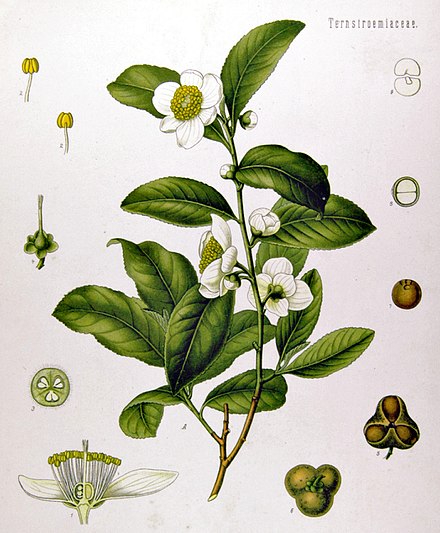
For the sake of ease and modernity, I call all infused drinks “tea”. OK- that’s settled.
As any experienced herbalist or novice herb grower knows, making herb tea is a simple way to use herbs, to enjoy the flavor and aroma of a particular herb or blend of herbs and to extract the health benefits of an herb.
This is a terrific time of year to collect herbs for tea. Whether you live in the northeastern U.S. and are looking at a cold, snowy winter where your outdoor herbs are no longer available, you live where your herbs still look great and are full and lush looking, or you live in Texas where we’re experiencing great heat and drought right now, this is a good time to harvest and dry your herbs for winter use.
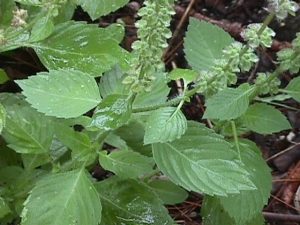
Holy Basil, aka Tulsi, growing at The Herb Cottage. A wonderful, healthful tea herb!
If you live in parts of the U.S. where the winters are cold and often fall below freezing, you’ll be looking at your garden right now realizing the beautiful growth you’ve enjoyed all summer is soon to be gone. It’s time to go out to your gardens and start harvesting your herbs. You don’t want to lose all those lovely herbs to the first frost.
Actually, you can harvest herbs that have been frozen outdoors. I harvest my lemon grass after it freezes. Just like freeze drying in your freezer!
Collect your herbs, wash them if necessary and let them dry off as much as you can… pat them dry, use a salad spinner or shake off as much water as possible. Label and bundle the herbs for hang drying in a dry, cool, airy place or place them on screens and dry them flat. You can even use your dehydrator.
Or, use your frost free refrigerator if you have room. Simply roll the fresh herbs in paper towels, write the date and variety of herb on the towel and place in a frost free refrigerator for a few days. Check and see if they’re dry. If not, roll them back up and leave them another day or two. You can fit a lot of herbs in your fridge this way. Just be sure to label them because sometimes it’s hard to tell lemon balm from a lemon mint when the leaves are dried.
Here is a more complete Feature Post I wrote on this technique for drying herbs.
If you live where your herbs are being stressed by heat and drought and thus looking poorly- like at my place these last few weeks!- go ahead and trim your herbs back now. You’ll need less water to keep them alive and they’ll reward you by flushing out with lots of new growth as soon as the temperatures cool down a bit.
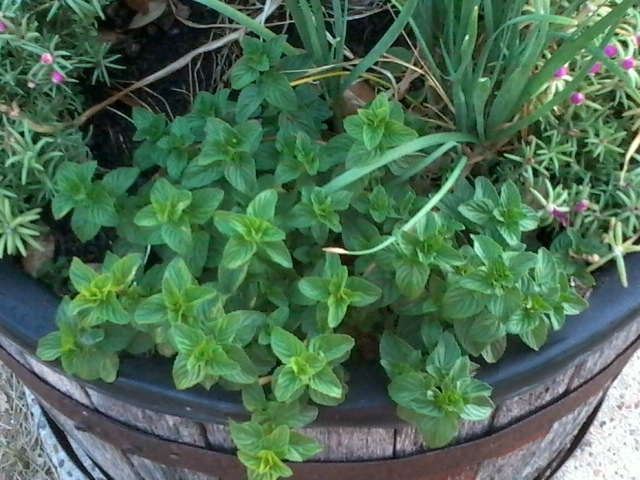
Some herbs can be pruned back harder than others. Be gentle with the thyme and rosemary. Only cut them back by about 1/3. Members of the oregano family, including all types of oregano and marjoram, can be cut back hard- to the soil level, if you like. New shoots will appear shortly. Just be sure to keep the soil a bit moist in this heat. Or, just cut back about 1/2 the length of the stems. New growth will appear on the stems.
Lemon verbena suffers this time of year at my place. So, I prune it back by about 1/2 and it bounces back beautifully. Another herb that doesn’t seem happy in my Texas heat is lemon balm. I cut it all the way to the ground as soon as it is done flowering and the bees have extracted all the nectar they can. It grows out into a nice, compact bushy plant starting in mid-September.
If you have basil that has yet to seed out or is just starting to seed, this is the time to harvest it for zesty pesto or to freeze for future use. Basil can certainly be dried like any other herb. I personally think it loses most of its flavor when dried. If I want to preserve basil alone, I chop it, place the chopped pieces in ice cube trays, pour some hot water over it to blanch it and freeze it. Then, I use it in soups, stews, sauces and the like all winter long.
Here’s an article from earlier this summer all about pesto, including ones made with basil.
A Tea Making Refresher
There are basically two ways to make tea- an infusion and a decoction.
For either method the rule of thumb is 1 teaspoon of dried material or 2 teaspoons of fresh material per cup. Adjust to your own palate, of course.
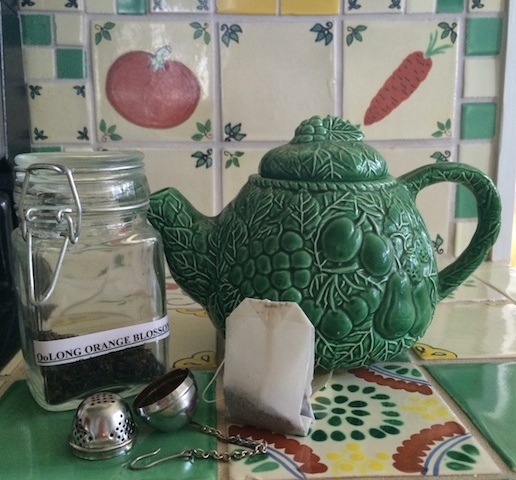
Tea Pot with tea bag, a tea ball and loose tea- all ready for Tea Time!
Infusion- pour hot- just boiled- water into a cup or tea pot containing the herbs, steep for 5-10 minutes, strain and enjoy. Feel free to add honey, agave nectar, stevia or – gasp!- sugar to sweeten. If you grow stevia, throw a few leaves in your tea pot to sweeten the whole batch. This method is used for black and green teas whether in a tea bag, tea ball or loose in a pot. It is also used for most leafy herbs and flowers which might go in your tea.
Decoction- add cold water and herbs or spices to a non-reactive sauce pan- glass, stainless steel, ceramic work great- bring the water to a boil, turn down the heat and simmer gently for 10-30 minutes, depending on the material. This method is used for any non-leafy, hard or brittle material such as seeds, roots and bark.
Some leaves also need a short simmer. Olive leaf and eucalyptus are examples of leaves that need to be decocted rather than infused because the leaves are very hard, unlike mints, lemon balm and such. Simmering for 10-20 minutes is long enough to extract the flavor and other properties of the leaves.
What Herbs Can I Use For My Tea?
If you’re unsure what herbs are good for tea, remember- any herb you can use for cooking- and more!- can be used for tea.
Throughout the ages, tea has been a common way to get the medicinal properties of plants into our bodies as well as to quench thirst or to simply enjoy the flavor of an herb. If you like the way a particular herb tastes or smells, try it in tea. Make a light brew at first so you’re not overwhelmed by the flavor. Or add it to a familiar tea to see how it blends.
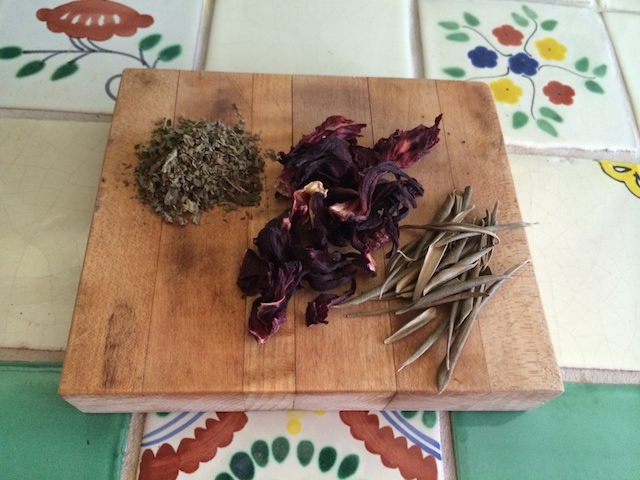
Many herbs that we do not use for flavoring but for their health benefits are delivered in tea form. These teas are often made stronger than tea for simple enjoyment and are infused or decocted for longer periods of time to extract more of the benefit of the herbs. This practice can cause the brew to become bitter, so often honey is added to make it more palatable.
A Word of Caution
Herbs are plants. Some people have allergies to plants. For instance, if you have an allergy to ragweed, chamomile tea is not recommended for you. There are other teas with calming effects that you can substitute for chamomile. If you are pregnant or nursing, some herbs in medicinal strength are contraindicated.
Most herbs prepared and enjoyed simply for their flavor and aroma are perfectly safe for “most” people. If you’re trying a particular herb in tea for the first time, be safe and only drink a little until you see if your body likes it or not.
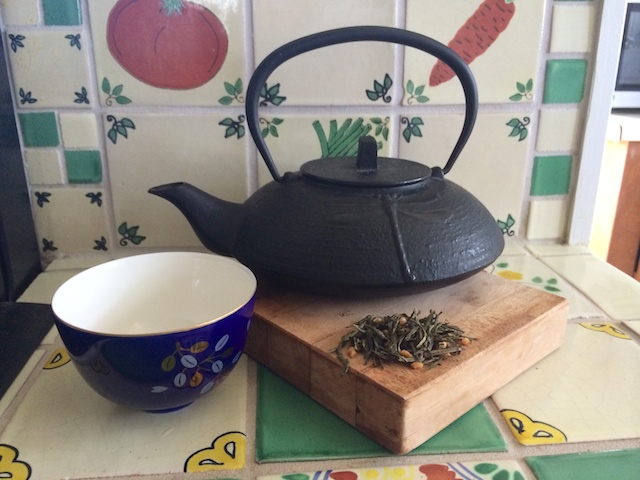
The green tea has roasted rice in it. What a flavor the rice adds- toasty!
Many, many people use herb teas to calm them before bedtime, to energize them during the day, to help boost the immune system, to calm an upset stomach and for myriad other reasons. Those people know the teas they choose work for them.
But, make no mistake- if you plan to use herbs as “medicine”, respect their strength. Just because something is natural, found in nature, does not mean it’s not powerful. Do your homework. There is lots of good, solid information out there in books and on the Internet to help you research herbs. Use more than one source and compare the information.
And, why not enjoy a cup of delicious herb tea you’ve made from your own garden while you’re reading? The world of herb tea is vast, filled with history, personal stories and, best of all, flavor!

QUOTE FOR THE MONTH
No amount of belief makes something a fact.
-James Randi, magician and skeptic (b. 1928)
